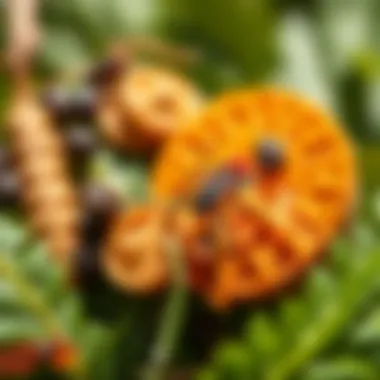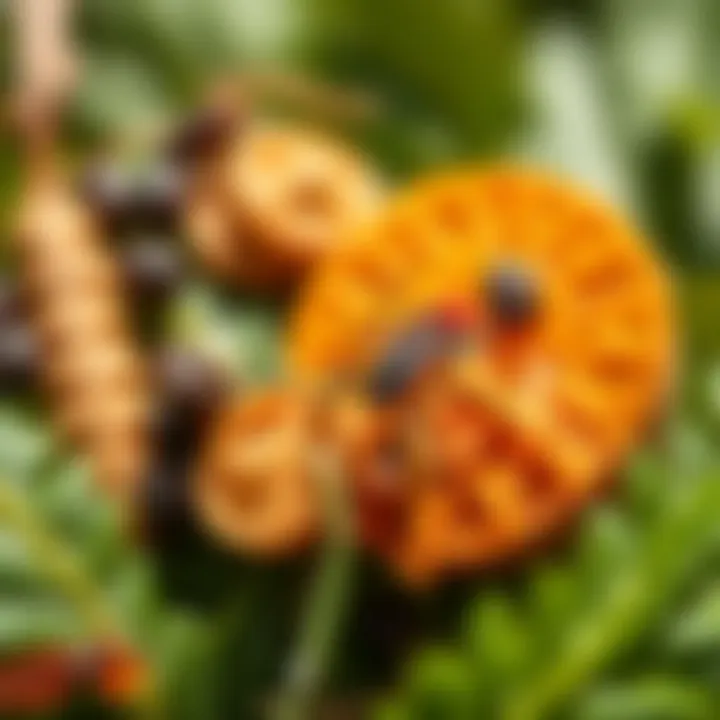Top Tick Control Products for Your Yard


Intro
Ticks are more than just a tiny nuisance; they pose a serious health threat to both humans and our furry companions. A simple stroll in the backyard could turn into a ticking time bomb if these pests are allowed to flourish. Addressing a tick problem needs more than just wishful thinking. Understanding how to control these pests effectively is paramount for maintaining a safe outdoor environment. This article seeks to provide housewives and homeowners with essential insights into tick control products, including their mechanisms and how to apply them effectively.
Pest Identification
Identifying ticks and understanding the signs of their presence is the first step in tackling a tick problem. Knowledge is power, especially when it comes to safeguarding your yard from these unwelcome guests.
Common Household Pests
In most yards, the primary culprits are the black-legged tick (also known as the deer tick) and the dog tick. The black-legged tick is particularly notorious for spreading Lyme disease. These little critters often lurk in grassy areas and wooded parts of your yard, waiting for unsuspecting humans and pets to pass by.
Signs of Infestation
How do you know if ticks have made your yard their home? Keep an eye out for:
- Unusual behaviors in pets like excessive scratching or biting at their fur.
- Presence of ticks on pets or clothing after spending time outside.
- Tick bites on humans, which may manifest as a small red bump or rash.
- Observing pets or people coming back with ticks attached on them after they’ve ventured into your yard.
"An ounce of prevention is worth a pound of cure." - Benjamin Franklin
Getting familiar with these signs can help you take action sooner rather than later.
Prevention Methods
Prevention is often the best strategy. A few environmental tweaks can vastly reduce the tick population in your yard.
Environmental Modifications
Consider these strategies:
- Keep grass trimmed short and remove debris like leaf piles where ticks can hide.
- Create barriers using wood chips or gravel to separate your yard from wooded areas.
- Designate pet play areas away from lush grass and thick bushes to minimize their exposure to ticks.
Home Maintenance Tips
Simple home maintenance can also help.
- Ensure that your home has clean gutters; stagnant water can attract ticks and their hosts.
- Regularly inspect your pets for ticks after they come in from outdoors.
- Seek professional pest control services when the infestation is severe.
DIY Pest Control Solutions
For those who prefer to take matters into their own hands, there are a variety of DIY solutions that can be effective.
Natural Remedies
Several natural repellents may help:
- Essential oils like lavender, tea tree, and eucalyptus can deter ticks when mixed with a carrier oil and applied to skin and clothing.
- Diatomaceous earth, a powder made from fossilized marine life, can be sprinkled in areas prone to tick infestations; this will dehydrate and kill ticks upon contact.
DIY Traps and Barriers
Creating barriers against ticks can also be effective:
- Homemade traps can be made using a bowl of soapy water; place in areas frequented by ticks. The ticks are attracted to the water and drown.
- Physical barriers like tick tubes, which you can fill with permethrin-treated cotton, can lure mice (which carry ticks) and eliminate them before they become a bigger problem for your yard.
By understanding how to identify ticks, the right methods to prevent their proliferation, and the various DIY solutions, you take proactive steps to protect your yard and your loved ones. With accurate knowledge and vigilance, you can significantly decrease the likelihood of ticks making themselves at home.
Understanding Ticks and Their Risks
Ticks are notorious little pests that can pose severe health risks to both humans and pets. To grasp their dangers fully, it's essential to delve into their biology, their habitats, and the health hazards they present. Understanding ticks can significantly influence the effectiveness of control measures, enabling homeowners to protect their loved ones effectively. People often overlook the importance of knowing who they are dealing with. It’s not just about applying a product; it’s about being informed.
Biology of Ticks
Lifecycle Stages
Ticks go through four distinct stages: egg, larva, nymph, and adult. This lifecycle spans several months to years, depending on the species and environmental conditions. The transformation from one stage to the next largely hinges on blood meals. Each stage has its unique vulnerabilities, making it pivotal for yard owners to time their control methods efficiently. For example, targeting nymphs is quite beneficial since they are often responsible for transmitting Lyme disease to humans. Their small size makes them hard to spot, but knowing when and where they feed gives you an upper hand.
Feeding Habits
Ticks are practically professional bloodsuckers. They require a blood meal at each stage of their lifecycle, which is where they pick up a cocktail of pathogens. Their feeding habits are both sneaky and strategic. They can sense body heat, carbon dioxide, and even moisture in the air to find their next host. Many people are unaware that ticks can survive for long periods without a meal, which makes it easy for them to establish a foothold in your yard. Understanding these habits allows for tailored control measures that are more impactful.
Habitat Preferences
Ticks thrive in humid, wooded areas, tall grasses, and shrubs. They prefer environments where they can stay moist but don’t mind a dappled sun. Knowing their habitat preferences is crucial for effective yard management. For instance, if your yard is adjacent to a wild area, you might need to take extra precautions. Simple landscaping changes, like keeping grass short and trimming shrubbery, can make your space less inviting for ticks.
Health Risks Associated with Tick Bites
Lyme Disease
Lyme disease is perhaps the most well-known risk linked with tick bites, primarily caused by the Borrelia burgdorferi bacterium. The disease manifests with various symptoms, including fever, fatigue, and the characteristic bullseye rash. If left untreated, it can lead to severe complications, impacting the joints, heart, and nervous system. Given its prevalence in certain regions, awareness of Lyme disease is vital for anyone spending time outdoors, especially in tick-heavy environments.
Other Tick-Borne Illnesses
Beyond Lyme disease, ticks can transmit several other illnesses, such as Rocky Mountain spotted fever, anaplasmosis, and babesiosis. Each of these diseases has its unique symptoms and consequences, which can range from mild to life-threatening. Knowing about the various tick-borne illnesses can empower you to act swiftly in case of a tick bite. Quick identification can be the difference between full recovery and prolonged health complications.
Symptoms and Prevention
Recognizing the symptoms of tick-borne illnesses early can save lives. Common signs include rashes, flu-like symptoms, and joint pain. Preventive measures can significantly reduce risks, such as using insect repellent, wearing protective clothing while out in the yard, and conducting regular checks for ticks after being outdoors. Prevention is always better than cure, and being vigilant can make your outdoor activities safer for everyone.
Identifying Tick Infestation in Your Yard


Recognizing the signs of tick presence in your yard is essential for effective pest management. Being proactive can save you and your pets from the serious health risks associated with tick bites. By learning how to identify infestations, you not only protect your family but also contribute to a healthier environment. The importance of accurate identification cannot be overstated—it lays the groundwork for choosing the right control methods.
Signs of Tick Presence
Visual Clues
One of the first things you can do is to look for visual clues. These may include the presence of ticks themselves on various surfaces or even on pets. Keeping an eye out for ticks in areas where your pets lounge or where people frequently walk, such as paths or grassy spots, can indicate an infestation. The crux of these visual signs lies in their immediacy; spotting a tick can trigger swift action.
While this seems straightforward, the unique characteristic of visual clues is that they sometimes can be misleading. For instance, if you only observe the occasional tick but have not yet addressed your yard's habitat, the situation could escalate quickly. Thus, while visual clues are beneficial in alarming you to the problem, they shouldn't be the sole criteria for assessing tick presence.
Presence of Hosts
The presence of hosts, such as deer, dogs, and even rodents, plays a crucial role in tick lifecycles. If you notice an abundance of these animals in and around your yard, it's an indication that ticks may not be far behind. This aspect is especially salient because many species of ticks thrive on specific animal hosts in order to complete their lifecycle.
This connection makes the presence of hosts a pivotal point; if you spot multiple animal tracks, it becomes apparent that the risk for tick infestation increases. However, a double-edged sword occurs here; while animals are a natural part of the ecosystem, they can encourage tick populations to grow. The unique advantage in assessing this factor is its predictive quality—you can anticipate potential issues before they arise.
Environmental Indicators
Tick activity often correlates with certain environmental indicators. Warm, humid environments tend to harbor ticks more than dry or cold ones. Leaf litter and tall grasses are ideal tick havens, providing conditions where they can thrive. When you see an abundance of overgrown vegetation or debris, you are likely dealing with an increased risk.
The key characteristic of these indicators is that they can serve as a dashboard for risk; dense, humid areas of your yard can paint a clearer picture of what to expect regarding tick activity. However, one must keep in mind that these indicators can evolve with seasonal changes. For instance, dense underbrush during summer months may pose a greater risk than when winter comes knocking. This characteristic can both increase your understanding of current conditions and serve as a reminder for seasonal yard maintenance.
Assessing the Risk Level
Once you've identified signs of tick presence, the next step is assessing the risk level.
Yard Location
The location of your yard can heavily influence tick infestation risk. Yards close to wooded areas or water bodies are more susceptible to ticks. Here, you need to consider that these locations often bring together various hosts—both wild and domestic. If your yard is situated in these zones, it's important to be vigilant, especially during peak tick seasons.
This characteristic emphasizes how yard location directly correlates with risk. If you live near a forest, the likelihood of ticks increases, meaning that preventive measures must be integrated into your yard care routine. On the flip side, this might seem daunting, but knowing your geographical risks allows you to tailor your tick management strategies effectively.
Surrounding Wildlife
The wildlife surrounding your property can act as carriers, bringing ticks in from the outside world. Animals such as deer, raccoons, or even stray cats can transport ticks right into your backyard. Observing these creatures provides invaluable information about the level of risk you face.
The key takeaway from recognizing surrounding wildlife is that it serves as a natural warning. If you spot animals frequently visiting your yard, don’t ignore it; this could be a crucial pointer towards evaluating tick risk. However, the downside is that you may not always be able to manage wildlife movements, which can complicate prevention efforts.
Vegetation Management
Effective vegetation management is crucial because ticks love to hide in thick, overgrown areas. If your yard has the tendency to become overgrown, this can significantly elevate your risk. Regular mowing and keeping areas clear of debris can minimize these ideal conditions for ticks.
The undeniable advantage of effective vegetation management is that it provides a straightforward approach to lowering tick numbers while also enhancing the overall aesthetic of your yard. This practical tactic encourages homeowners to take an active role in their yard’s upkeep. However, it does require ongoing effort and commitment, which can be a disadvantage for some.
Taking the time to identify tick infestation signs and assess risk levels provides a solid foundation for effective yard management. It allows you to take informed steps before ticks truly become a problem.
Types of Products for Tick Control
Understanding the different types of products available for tick control is essential for homeowners aiming to keep their yards free from these pesky pests. Each product category offers its unique advantages and considerations, making it crucial to explore these options thoroughly. By choosing the right products, you can enhance your ability to protect your family and pets. This section dives into the most effective kinds of tick control products, divided into chemical pesticides, natural alternatives, and repellent granules, ensuring you have all the necessary information to make informed decisions.
Chemical Pesticides
Chemical pesticides have long been a go-to solution for pest control, including ticks. Their ability to deliver quick and effective results makes them appealing for homeowners.
Active Ingredients
The active ingredients in chemical pesticides play a pivotal role in their tick-eliminating power. Common components like permethrin and bifenthrin are known for their potency. What makes these ingredients beneficial is their ability to disrupt the nervous systems of ticks, leading to their quick demise. However, while effective, these chemicals can also raise concerns regarding their safety for humans and pets, which is why understanding how they work is essential.
Application Methods
When it comes to application methods, homeowners have options ranging from sprays to granules. Spraying is a straightforward technique that allows for wide coverage, making it popular among those looking to treat large areas quickly. However, following the manufacturer's instructions is paramount to avoid any mishaps that could lead to over-application or waste. While chemical pesticides can be effective, careful consideration must be given to timing and environmental factors.
Effectiveness and Longevity
The effectiveness and longevity of these products depend on various factors, including the specific brand and the environmental conditions in which they are applied. Many chemical pesticides boast several weeks of protection, making them a practical option for ongoing management. However, users must be aware that some products may require reapplication after rainfall or significant moisture.
Natural and Organic Solutions
For those inclined towards more environmentally friendly options, natural and organic solutions present viable alternatives.
Essential Oils
Essential oils like lavender, cedarwood, and peppermint can serve as effective tick deterrents. Their aromatic properties are not only pleasant to humans but also disturb the receptors in ticks. They offer a more holistic approach to pest control, but users must note that they often require more frequent application than synthetic options to maintain effectiveness.
DIY Sprays
Creating do-it-yourself tick sprays has become a popular choice for those who prefer a hands-on approach. Using ingredients like vinegar and water, along with essential oils, DIY sprays can provide a sense of control over what is used in your yard. However, the effectiveness of these solutions can vary, and they may not provide the same immediate results as commercial products. Ensuring the right ratio and application technique is key to their success.
Environmental Impact
One of the standout features of natural solutions is their lower environmental impact compared to chemical counterparts. They pose fewer risks to non-target species and contribute near-zero pollution. However, while they are eco-friendly, their efficacy can sometimes trail behind synthetic options, especially in severe infestations.
Tick Repellent Granules
Tick repellent granules offer a different method of yard treatment, delivering long-lasting action directly into the ground.
Use Cases
These granular products are particularly useful in areas where water applications might wash away chemical treatments. They provide a slow-release effect, consistently targeting ticks over time. This makes them a good choice for preventative measures, especially in places prone to tick populations.
Application Techniques


Employing proper application techniques increases the efficiency of these granules. Spreading them evenly during dry conditions will enhance absorption into the soil. Homeowners should also consider granules as part of an integrated pest management plan, combining them with other control methods for augmented protection.
Advantages and Disadvantages
On the plus side, tick repellent granules are user-friendly and often safe for pets when applied as directed. However, one downside is their slower action compared to liquid pesticides, meaning existing ticks might not be eliminated immediately, requiring patience and possibly further treatments.
Understanding these various products forms the backbone of effective tick management in your yard. By weighing the pros and cons of each product type, you can tailor your approach to fit your specific needs and environment.
Evaluating Product Effectiveness
In the quest to manage ticks in your yard, understanding the effectiveness of various products is essential. This section delves into how to evaluate these products, ensuring you select the most suitable ones for pest control. Effectiveness isn't just about killing ticks; it also involves considering safety for humans and pets, environmental impact, and residual activity. A thoughtful evaluation leads to informed decisions, saving you time and money while maximizing protection for your loved ones.
Field Trials and Research Insights
Study Findings
Research and field trials provide a wealth of information regarding how different tick control products perform in real-world scenarios. Many studies highlight the effectiveness of products containing permethrin and other active ingredients, showing promising results in reducing tick populations. For instance, a study from the University of Rhode Island showed that certain chemical sprays yielded a 90% decrease in tick encounters when applied correctly.
Key Characteristic: The scientific backing of these findings offers reassurance that selected products are effective under controlled conditions, making them a beneficial choice for homeowners.
Unique Feature: What sets these studies apart is their rigorous methodology, often conducted over multiple seasons to evaluate long-term effects. However, it is crucial to weigh their real-world applicability, as conditions vary across different yards and environments.
Consumer Reviews
When assessing product effectiveness, consumer reviews serve as valuable insights from real users. Analyzing feedback on platforms like Amazon or gardening forums can shed light on how well products perform outside of laboratory settings. Many users rave about granular tick control products, citing noticeable reductions in tick sightings within weeks of application.
Key Characteristic: The first-hand experiences highlight practical outcomes and provide a nuanced view of how effective each product genuinely is. It’s a practical, popular means to evaluate tick control methods because many consumers share their success stories or challenges, offering a spectrum of perspectives.
Unique Feature: However, not all reviews are created equal; it’s wise to look for patterns in feedback and consider different yards' environmental factors and user expectations. This diverse feedback loop can be both a strength and a limitation in gauging effectiveness.
Long-Term Efficacy
The sustainability and long-term impact of tick control products are critical considerations. Evaluating how long a product maintains its effectiveness is crucial. Some studies have shown that natural sprays, though effective initially, may require more frequent reapplication compared to synthetic ones, which can last longer.
Key Characteristic: Understanding long-term efficacy helps you plan maintenance schedules effectively, thus saving you from repeat expenses and maximizing safety. Knowledge of a product's duration is a solid consideration, ensuring you are not continually running back to the store for replacements.
Unique Feature: Still, it’s essential to consider how these reapplications can influence both budget and environmental health. Natural products might be safer but could cost you more time and frequent applications, making balance key in your choice.
User Experiences and Recommendations
Case Studies
Examining case studies can provide instructive examples of the effectiveness of tick control products. In one instance, a community in New Jersey implemented an integrated pest management strategy using chemical sprays in combination with habitat modification. This multi-faceted approach dramatically reduced tick populations, further validating the synergy between different methods of control.
Key Characteristic: These case studies emphasize how combining different strategies can yield exceptional results, making them a valuable educational asset for homeowners.
Unique Feature: The collaboration of local communities and pest control experts underscores the importance of sharing knowledge and resources, helping other homeowners formulate their own strategies.
Comparative Analysis
Comparative analysis allows homeowners to juxtapose various tick control products and strategies side-by-side. For instance, comparing granules to chemical sprays may reveal differing levels of effectiveness and safety. Looking at safety ratings and user feedback on granular products versus sprays can inform significant purchasing decisions.
Key Characteristic: By understanding the pros and cons associated with each type, you can make a more informed choice tailored to your unique yard environment.
Unique Feature: However, while analyses highlight distinctions, they might not account for personal preferences, such as a homeowner's aversion to chemicals, even if those are backed by strong research.
Expert Opinions
Expert opinions from entomologists and pest management professionals can provide an additional layer of clarity regarding product effectiveness. Many experts recommend particular active ingredients known for their efficacy in controlling tick populations. They often emphasize that understanding the lifecycle of ticks is crucial in timing applications effectively.
Key Characteristic: Relying on expert insights offers a more comprehensive understanding of which products will perform best in given conditions, making their input beneficial in this discussion.
Unique Feature: Nevertheless, experts may vary in their recommendations based on personal experiences or specific regional challenges, thus emphasizing the necessity for localized advice when choosing products.
Applying Tick Control Products Safely
When you’re tackling the issue of ticks in your yard, safety is paramount. It’s not just about getting rid of these unwanted pests; it’s also about ensuring that you, your family, your pets, and the environment stay well protected. Using tick control products without a fuss can lead to harmful consequences. This section will consider the essential safety precautions to take, as well as the environmental factors that come into play when using these products.
Safety Precautions
Protective Gear
Wearing the right protective gear can be the difference between a safe tick management operation and a potential disaster. Gloves, masks, and protective clothing are not just recommendations; they are essential when handling pesticides and other tick control products. The key characteristic of such gear is its ability to create a barrier between your skin and harsh chemicals, ensuring you don’t absorb anything potentially harmful. One beneficial choice for this type of gear is nitrile gloves, which are resistant to many substances and provide a tighter fit compared to latex, reducing the risk of accidental exposure.
Moreover, wearing long sleeves and pants can help cover more skin, especially in areas known for tick infestation. The unique feature of durable, breathable fabrics can prevent overheating while adding that extra layer of protection. However, while protective gear is effective, it's important to ensure proper fit and avoid any loose clothing that could snag on vegetation or equipment during application.
Application Timing
The timing of applying tick control products is crucial. Applying them when conditions are ripe can maximize their effectiveness. For instance, early morning or late afternoon can often be the best times due to lower temperatures and dew that may help bind some granules and liquid treatments to the ground. The key characteristic of strategic timing lies in the potential for rain or high temperatures that could wash away products or cause them to evaporate quickly, reducing their effectiveness.
Choosing off-peak hours not only reflects consideration for your family’s safety but also the local wildlife which may be more active during different times of the day. A unique feature of planning application around weather patterns is a mix of efficiency and precaution. Failure to consider timing can lead to wasted effort and resources, and increased risk of exposure to humans and pets.
Exposure Guidelines
Understanding exposure guidelines is another vital aspect of safe tick control product application. It informs users of how to minimize risks associated with chemical exposure for themselves and others nearby. The key characteristic here is the recommended waiting periods after applying these products; typically, it’s advisable to keep kids and pets off treated areas for a certain duration. This can vary widely based on the specific product being used, so it’s intelligent to read labels carefully.
The unique feature of clear guidelines is that they emphasize the importance of safe practices that can prevent health issues resulting from chemical exposure. Ignoring these instructions may not only put you at risk, but it can also jeopardize your yard’s biodiversity and health. Therefore, always ensure that you’re monitoring not just yourself, but also the environment after treatment.
Environmental Considerations
Impact on Non-Target Species


The impact products can have on non-target species, such as beneficial insects and nearby wildlife, must be a central consideration. Many pesticides can affect bees and other pollinators, leading to a decline in local ecosystems. The key characteristic of eco-friendly products is that they offer solutions that target ticks specifically while being less harmful to other species. Opting for such solutions is a benificial practice that allows homeowners to control pests without unintentionally harming the environment.
However, even eco-friendly options can have unexpected effects if misapplied. It's essential to consider factors like drift or runoff that might carry active ingredients beyond the intended area, leading to broader environmental consequences. A proactive approach pays off here, as maintaining a garden rich in native plants can provide refuge for beneficial insects, creating a balanced ecosystem.
Soil Health
The health of your soil is crucial, and the products you apply can impact it greatly. Chemicals can lead to nutrient depletion or alter microbial communities essential for soil vitality. The key characteristic of a good tick control strategy is one that recognizes this interdependence between soil and overall yard health. Utilizing natural or organic tick control methods can protect soil health while achieving desired pest management results.
The unique feature of maintaining soil health is that healthy soils are likely more resilient against pests and diseases overall. For example, regular applications of organic compost can fortify soil while repelling ticks, fostering a sustainable solution. On the flip side, over-reliance on chemical solutions could deplete valuable soil nutrients, leading to long-term issues.
Water Runoff Concerns
Water runoff concerns arise particularly when applying tick control products. Rain can wash poorly applied substances into nearby waterways, harming aquatic life in the process. The key characteristic we should focus on is maintaining a buffer zone—an area devoid of chemicals between the treated yard and any water sources. This practice is essential in protecting local wildlife and water quality.
A unique feature of managing runoff is considering landscaping as a means to an end. Creating swales or bioswales—areas designed to capture and manage stormwater—can help mitigate this runoff, and protect both your yard and the greater environment. It reflects the understanding that managing ticks doesn’t have to sacrifice the health of our neighborhoods and ecosystems.
In summary, when applying tick control products, it’s crucial to stay informed and responsible. From protective gear to application timing and consideration of environmental impacts, each aspect comes together to form a comprehensive strategy that prioritizes not just the elimination of ticks, but the health and safety of everyone involved.
Long-Term Strategies for Tick Management
When it comes to tick control, a short-term fix isn't going to cut it. Ticks are persistent little critters, so adopting long-term strategies can be the difference between a comfortable yard and an unhealthy environment for your family and pets. Effective management goes beyond just applying products. It requires a comprehensive plan that involves eco-friendly practices, community efforts, and an understanding of the tick lifecycle. Ultimately, these strategies not only minimize tick populations but also enhance the overall health of your outdoor space.
Integrated Pest Management (IPM)
Integrated Pest Management is the gold standard when it comes to dealing with ticks. It isn't merely a single method; rather, it's a holistic approach that combines various techniques, tactics, and strategies.
Combining Methods
One of the primary strengths of combining methods in IPM is its diverse approach to problem-solving. By using a mix of cultural, physical, biological, and chemical measures, you’re less likely to build resistance in ticks. For instance, using a repellent spray along with natural barriers can maximize effectiveness. It gives you flexibility, allowing you to tailor solutions to specific areas of your yard. The biggest upside is that if one method shows diminishing returns, others can fill the gap, ensuring your home remains tick-free while minimizing potential chemical exposure for your family.
Monitoring and Assessment
Regular monitoring and assessment play crucial roles in keeping ticks in check. By regularly examining your yard for tick activity, you gain valuable insights into how effective your strategies are. This doesn’t have to be complicated; simple observations—like tracking tick sightings or the population of hosts—can tell you a lot. Have the number of ticks gone down since you applied measures? Are there still signs of host activity? This ongoing evaluation helps to tweak your approach as necessary.
The key here is being proactive rather than reactive. If monitoring shows an uptick in ticks, you can take immediate action rather than waiting for a full-blown invasion. It’s essentially a preventive measure that allows you to stay one step ahead, keeping your family and pets safer in the long run.
Community Approaches
A good tick control strategy extends beyond individual yards to encompass community efforts. Community approaches can amplify your results, creating a collective safety net. Think about it: if everyone in your neighborhood is taking measures to manage ticks, it significantly reduces the chance of re-infestation from neighboring properties.
Living in a community allows for resource sharing. Perhaps neighbors can organize a community-wide tick control day, pooling efforts to address tick populations more effectively. Furthermore, this creates awareness about the risks associated with ticks, empowering everyone to participate in better management.
When communities band together, you wield the power of numbers. The downside? It requires coordination and commitment, which can sometimes be an uphill battle depending on individual motivation.
Landscaping Practices to Reduce Tick Habitat
You can also employ savvy landscaping practices to discourage tick activity right in your yard. This isn't just about aesthetics; it’s about improving conditions so ticks can't thrive.
Mowing Techniques
Maintaining your grass at a shorter height is essential. Regular mowing techniques reduce the potential hiding places ticks thrive in—long grass, overgrown shrubs, and so forth. The practice not only makes your yard less inviting for ticks but also discourages their unfortunate hosts, like deer and mice, from sticking around. A big upside here is that it's low-cost and easy to implement. Just don’t let your grass grow wild!
Wildlife Barriers
Installing wildlife barriers can distract potential hosts from entering your yard. Fencing, for instance, can serve as a deterrent to deer, which are known to carry ticks into gardens. Moreover, using materials like gravel or wood chips can create a physical barrier along areas where wildlife may roam.
The advantage of this method is that it serves a dual purpose: not only do you restrict tick influx, but you can also beautify your landscaping at the same time. On the downside, installation costs might be a bit higher initially, although the long-term benefits can outweigh this.
Plant Selection
Choosing the right plants can significantly aid in tick management. Certain plants naturally repel ticks, which is fantastic when combined with a broader approach. Think of plant selection as a natural form of pest control. You might want to consider planting garlic, mint, or lavender around your yard. These can help keep ticks at bay while still allowing your space to look appealing.
The downside? It may take a little time for the benefits to show as you need to allow for growth. However, it's worth noting that not only are you keeping ticks at bay, but you’re also making your yard a more inviting place for humans.
In summary, long-term strategies for tick management go beyond surface-level remedies. They require a nuanced approach to understand and mitigate tick habitats while enhancing your yard’s natural ecosystem, ultimately leading to a safer and more enjoyable outdoor environment.
Frequently Asked Questions
When it comes to tackling ticks in your yard, knowledge is power. The Frequently Asked Questions section is vital for demystifying common concerns homeowners have about tick control products and their practical use. Addressing these questions offers a clearer perspective on the management of ticks, allowing folks to make informed, effective decisions to protect their families and pets. This part serves not only as a clarification of doubts but also as a guide to optimizing your lawn's safety from these pests, which can transmit serious illnesses.
How Often Should Treat My Yard?
The frequency of yard treatments can depend on a variety of factors, including the tick population in your area, the environment of your yard, and the type of product you are using. Generally speaking, treating your yard every 3 to 4 weeks during peak tick season is advisable. Many homeowners overlook the seasonal nature of tick activity. In some regions, ticks can be active as early as March and may linger until late fall. Therefore, monitoring your yard during these periods is paramount.
- Consider the weather: Wet and humid conditions can promote tick breeding. If you've had a soggy spell, it might be wise to reevaluate your control strategy sooner.
- Use indicators: Regularly inspect your yard for signs of ticks, like found in dense, cluttered areas. If you see them popping up, you might need to step up your treatment routine.
It's all about being proactive rather than reactive. Skipping treatments can lead to rapid tick resurgence, which is the last thing you want with kids and pets running about.
Are There Any Eco-Friendly Options?
For those concerned about the environmental impact of chemical pesticides, the good news is that you have eco-friendly options. Organic tick control products have gained traction due to their natural ingredients that are less harmful to the environment.
- Essential oils: Oils like lavender, tea tree, and peppermint are known for their repelling properties. Not only do they deter ticks, but they also smell good!
- Diatomaceous earth: This natural powder can be sprinkled around your yard. It works by dehydrating ticks, without the harsh chemical side effects.
- Beneficial nematodes: These microscopic organisms can be introduced to your soil. They prey on tick larvae, helping to reduce their population over time.
Using eco-friendly products is a win-win situation; you can protect your family and pets while being considerate of the surrounding ecosystem.
Can Ticks Return After Treatment?
A common concern among homeowners is the possibility of ticks reestablishing themselves post-treatment. The short answer is: yes, ticks can come back even after effective treatment. Ticks are hardy little critters and can thrive in many environments.
Here's why they might return:
- Surrounding wildlife: If your yard is near dense woods or frequented by wildlife like deer or rodents, reintroduction of ticks can happen quite easily. These animals can bring ticks into your yard.
- Continuous reproduction: Female ticks can lay thousands of eggs, leading to potential infestations continuously throughout the season.
To minimize the risk, it’s advisable to combine treatments with ongoing vigilance. Regularly check for ticks on pets and family members. When outside, wearing light-colored clothing makes it easier to spot any ticks that might hitch a ride, and using a tick repellent can help further reduce your exposure.
In summary, understanding ticks and the treatments available helps you stay ahead in the constant battle against these pests.















